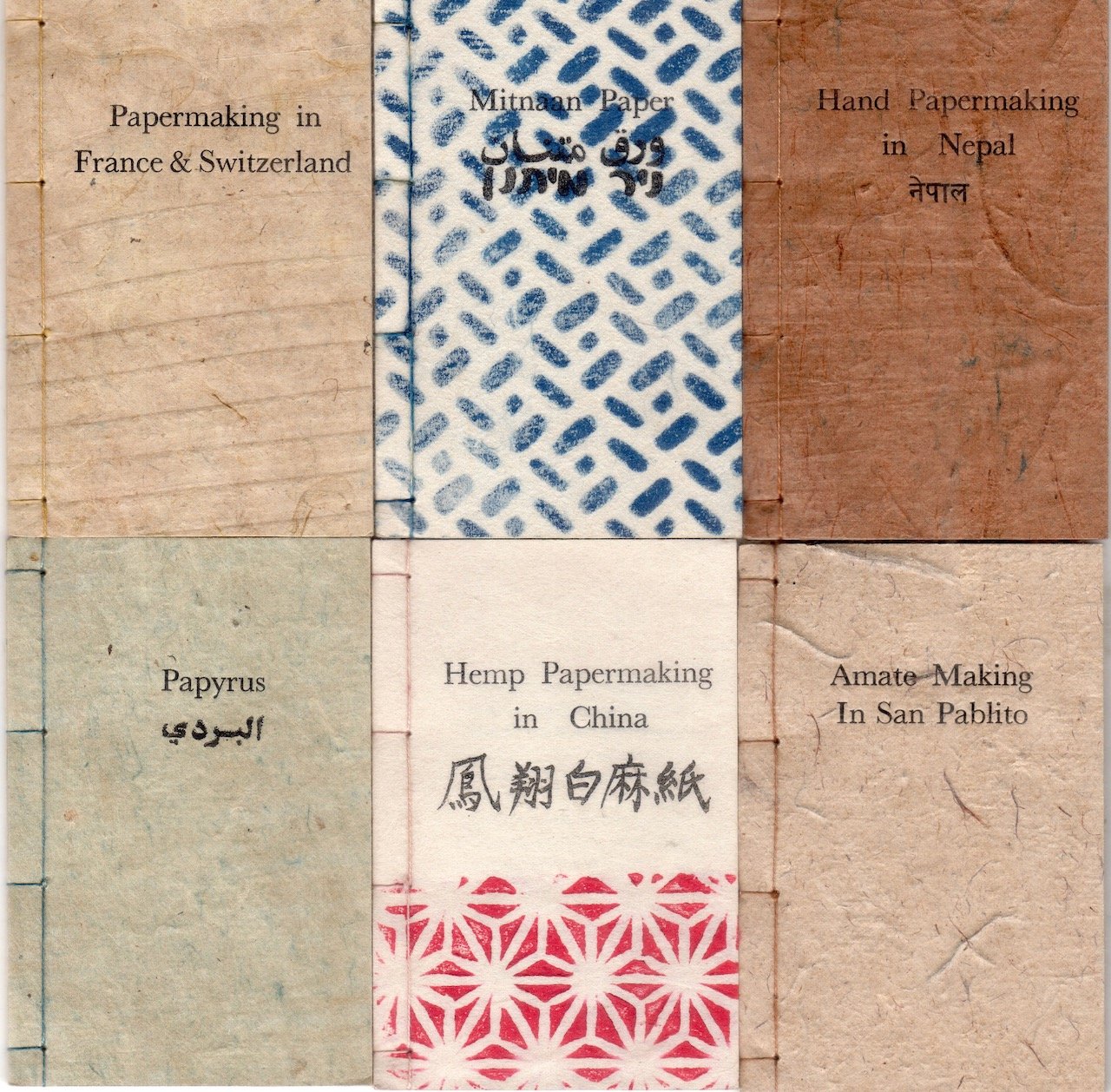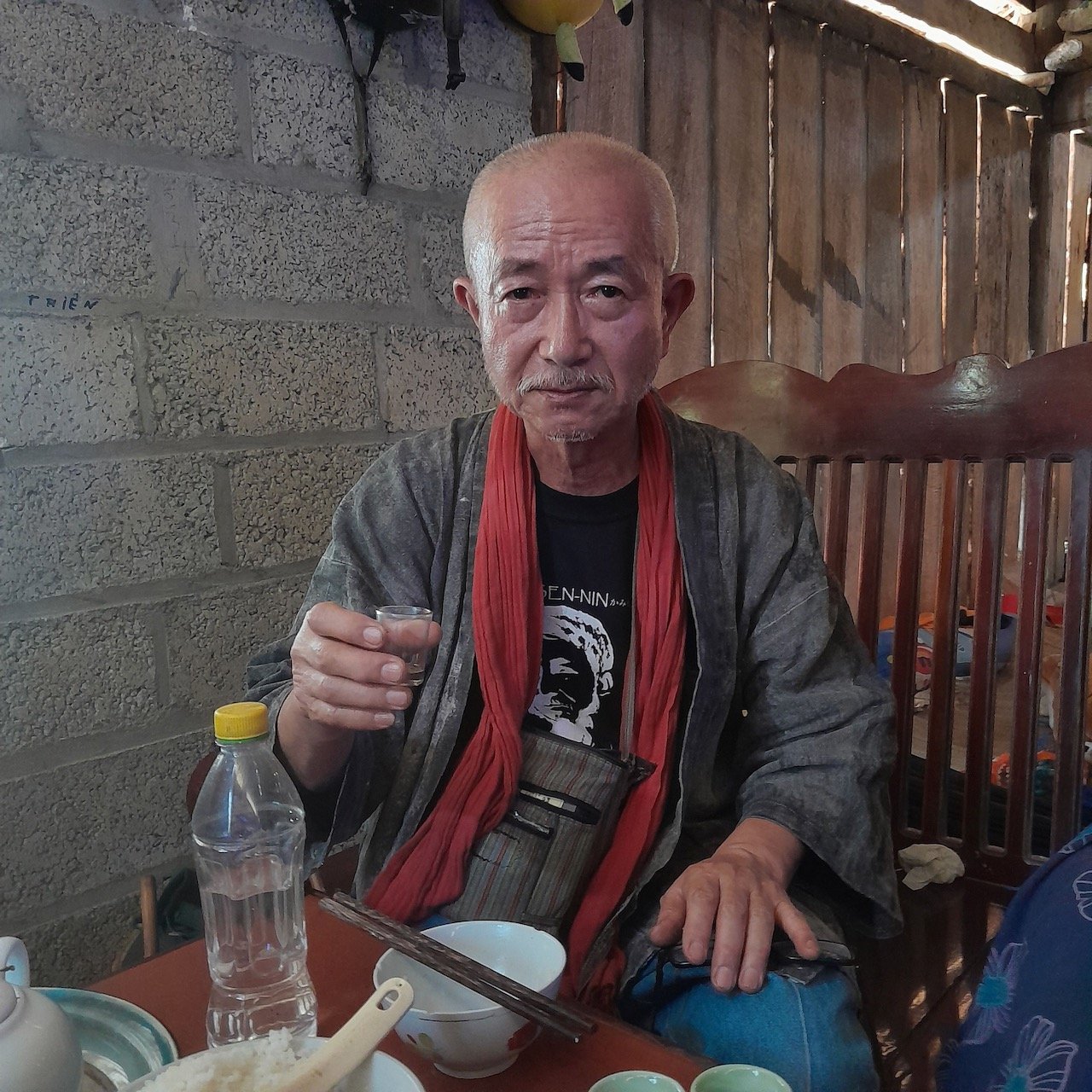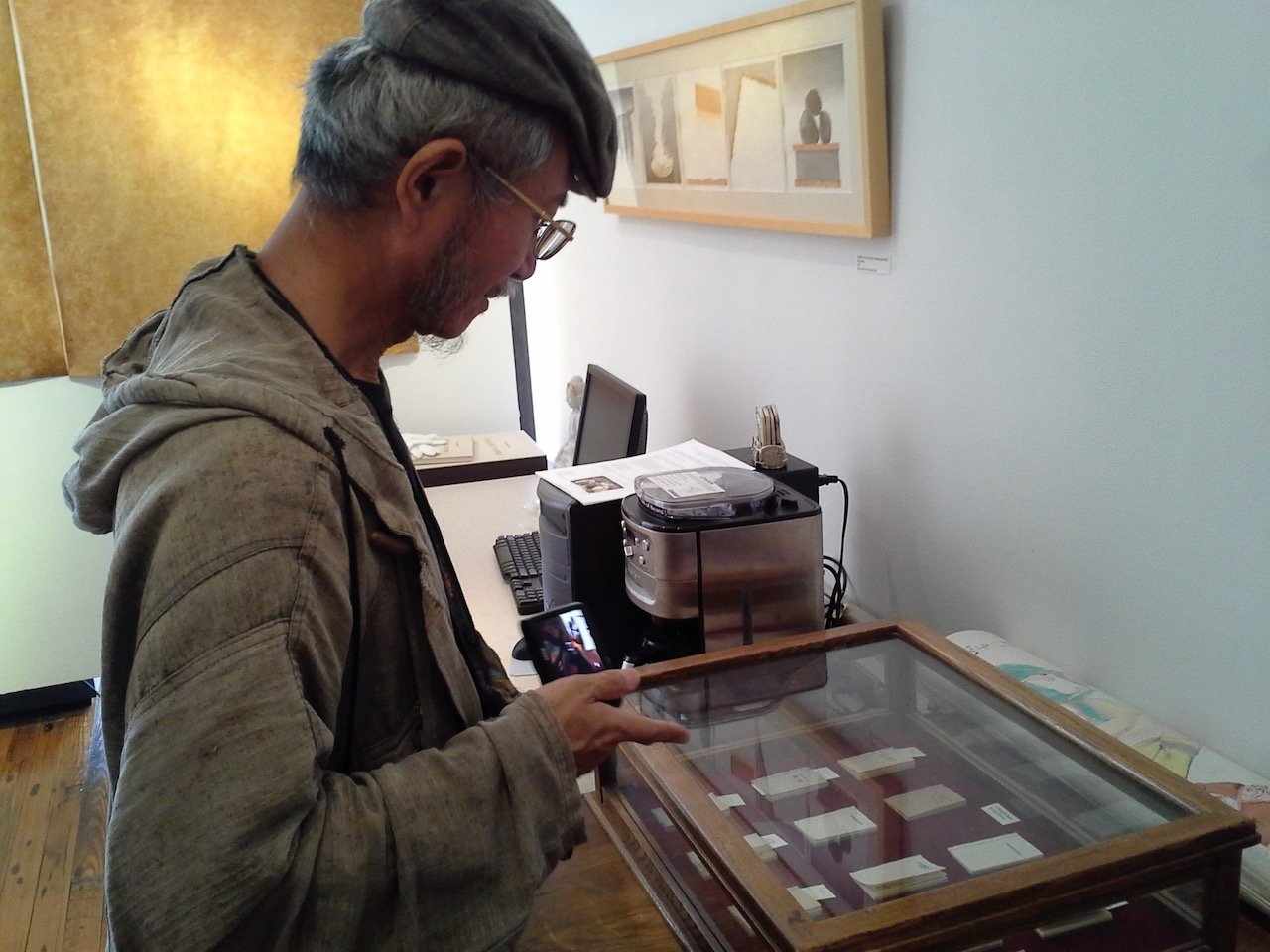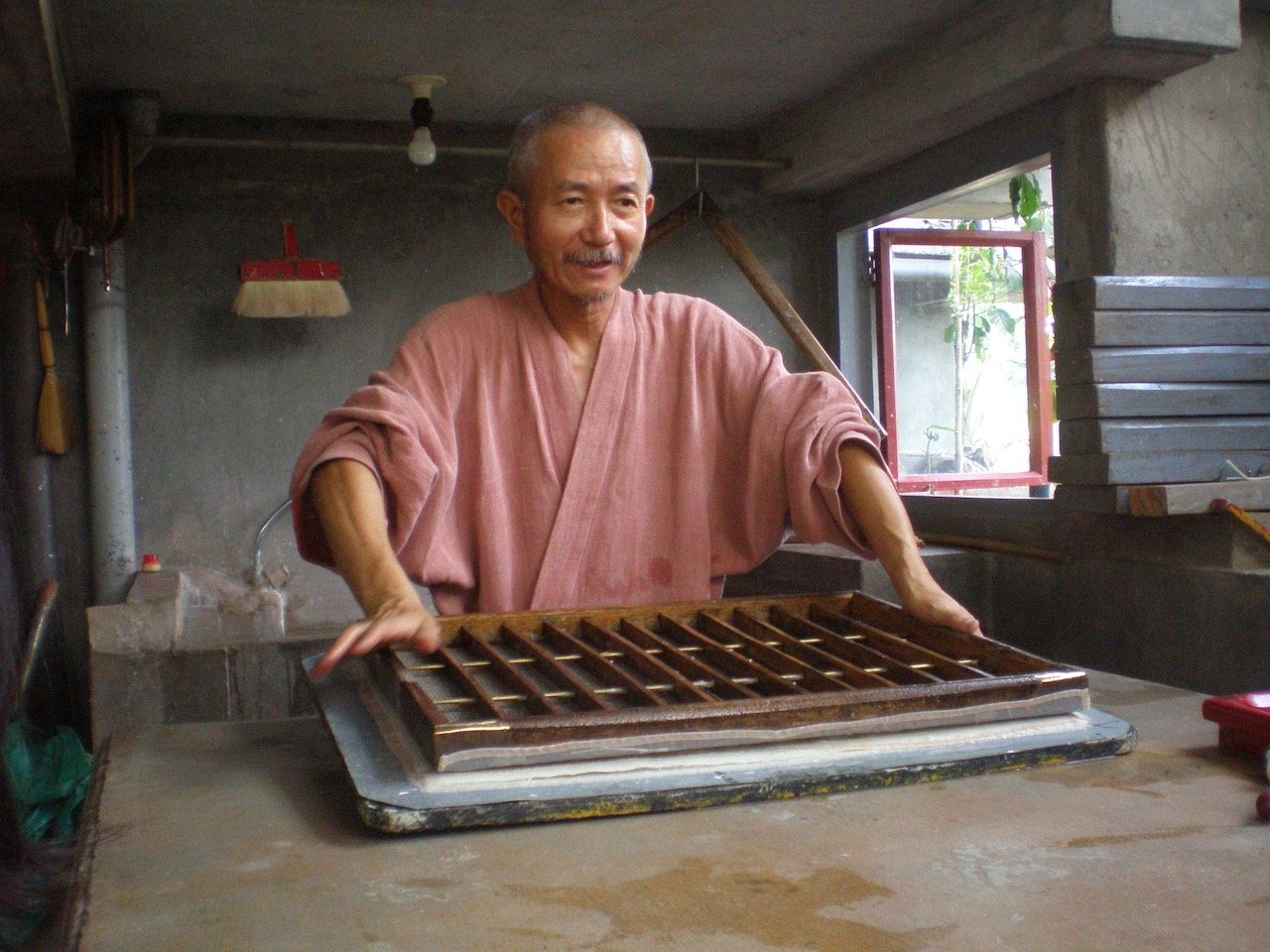
Asao Shimura
PAPERMAKING CHAMPION
Asao is a papermaker, paper researcher, world traveler, and teacher with expertise in papermaking, natural dyes, shifu, kon'nyaku, and other specialties. Well known for his many miniature books on handpapermaking subjects, Asao has been engaged with and supportive of the handpapermaking community around the world since the mid 1970s.
Asao Shimura
Essay by Aimee Lee
Asao Shimura has lived a life so rich and layered, with a spirit of constant inquiry and adventure, that I find it hard to imagine any one person covering so much ground in a single lifetime. To celebrate him, I offer how his work weaved into my consciousness around hand papermaking and its myriad possibilities.
I first encountered Asao’s name in my final year of graduate school in 2006, while interning with Robbin Ami Silverberg in Brooklyn. She had printed proverbs about women’s work onto her colorful handmade paper, and my job was to slice between the words so that each sheet became a continuous tape that she reeled onto wooden spools. She showed me examples of techniques that she had modified for her installation, in letters and shifu samples that a singular Asao Shimura had mailed to her. She said he was a Japanese man living in the Philippines who did lots of research and practice in papermaking and shared it widely by mailing books, newsletters, samples of paper, and paper-related items to people around the world.
In 2008, when I arrived in Korea on my first Fulbright research trip, I contacted Asao via email, after tips from Dorothy Field and Velma Bolyard. At that time, internet access was not ubiquitous. Asao wrote from internet cafes in Manila and Dagupan City; even in the US, Velma was on dial-up. I explained my research in Korea to Asao and he replied generously, inviting me to the Philippines, which I never managed to do, though he has hosted and taught many papermakers and artists at his home in sitio Poking, Benguet Province. (A “sitio” is a territorial enclave; sitio Poking has 45 households with 200 people total.)
Asao mailed all of his research on Korean papermaking to me in Seoul, from his miniature letterpress-printed book, Papermaking in Korea (based on 1977 field work with Timothy Barrett in Shin Heung Ri, Korea), to the hefty volume Kami ’89 that included an article by Dorothy Field on ondol paper, to letters and CDs that contained visual information that was so bountiful he could not print and mail or even email it all. I mailed a check for what I could spare at the time as a token of my thanks, and his correspondence kept coming. He was making paper with rice straw and pineapple, and training people to make paper and shifu to see if these crafts could provide financial support to Ifuago province. He also worked with saba banana and bamboo, and constantly had ideas for materials to test.
What I didn’t know then about Asao was that he already had published well over 30 books under his imprint Asa Press (CP), formerly Cannabis Press, and before that Bunseido Press (named after the bookshop his father ran). He had studied industrial chemistry and water analysis at Tokyo Technical College and immersed himself in Japanese papermaking, indigo dyeing, and related skills while living for a decade in an uninsulated farmhouse in Ibaraki prefecture. For his giant project, “A Paper Thatched House (APTH) 1987,” he made 8,300 4x6-inch sheets to brush onto the walls of the house. To share his research, he published 2x3-inch books with hand-set type on a table-top platen press, bound by hand, including samples. I found later that these miniature books were widely collected by individuals and institutions, but I was more accustomed to his inkjet-printed 4x6-inch books, the format he adopted after he moved to the Philippines. Kami ’89 was a 216-page commemoration of the International Paper Conference: Ibaraki ’89, which he organized for 54 participants from 15 countries over four days in August 1989.
By then, Asao had traveled around the world to research paper arts and history, from the inaugural 1975 International Hand Papermakers’ Conference in Appleton, Wisconsin (USA) to the 1978 International Association of Paper Historians Congress in Manchester (UK). In 1981, he began to lead Washi Tours for people interested in Japanese culture and papermaking. Over 20 groups encountered important papermakers, museums, temples, performances, shops, sushi and kami nabe meals, documented by his videos and books. Barbara Moon Boertzel shared her experience of Washi Tour ’83, where he drove seven women 1,200 miles over two weeks through Honshu and Shikoku islands. When viewing his video from his final Kami Tour in 2004, I marveled at how much organization, energy, and translation these trips required.
In 1989, Asao moved to Baguio city in the Philippines to manage the now defunct Duntog Foundation Inc., a papermaking center. There, he met fellow employee Andrea whom he married in 1991; they had four children and live in sitio Poking. He went on to consult for Kami Philippines Inc. (researching pineapple leaf fiber, piña, for paper and shifu) and Nezen Weaving Co. Ltd. in Japan, and directed Masa Ecological Development Inc. In 2009 he began the Traditional Papermaking Village Project (TPVP), to develop a cottage papermaking industry from rice-straw waste gathered by farmers in Ifuago province. He has taught, consulted, or done research in Australia, Canada, Denmark, France, Korea, Mexico, South Africa, Switzerland, UK, US, and Vietnam. People he encounters join a large web of friends and supporters, whose art he has gathered into Mini-Exhibitions (M-E) that he has mounted in Guam, Japan, and the Philippines. He published books about M-E to expand art made with products he shepherded: paper and shifu from banana stems, rice straw, pineapple, and bamboo.
After I returned to the US in 2009, Asao asked me to write about hanji for his Kami newsletter. When he visited my first hanji teacher in Korea the following year, he shared pictures and granted me permission to use them in my own book. After the 2010 IAPMA meeting in Korea (Wonju), he returned often to teach and meet scores of artists, professors, and papermakers. In 2011 he taught konnyaku workshops at the Hanji Industry Support Center in Jeonju and continues his long-standing inquiry into the historical migration of deckle sticks used in the sheet-forming process in different papermaking cultures.
In 2012, Tim Barrett and I brought Asao to the US on a mini-tour of four cities: New York, Syracuse, Cleveland, and Iowa City. We planned his visit to coincide with the combined meeting in Cleveland of IAPMA and the Friends and Dard Hunter (now North American Hand Papermakers). When I met Asao at LaGuardia Airport on his arrival in New York, I was shocked to see that one of his checked bags was a large taped cardboard box. His konnyaku workshop hosted by the Center for Book Arts was scheduled to take place at Robbin Ami Silverberg’s newly rebuilt studio in Brooklyn, but beforehand he wanted to visit Carriage House, among many other locations. With over 25 years on me, he walked so quickly that I was almost jogging to keep up. The International Paper Museum was exhibiting Paper Curiosities, where his miniature books were displayed along with things that he had made, such as a roll of handmade piña toilet paper.
During a stop to sit indoors and relax with beverages, we talked for a bit before Asao said he needed to leave because the air conditioning was unbearable; he lives without climate control. I knew he had a lot of back pain and that the trip was not easy, but he rarely complained. After NYC, he traveled to Syracuse and then to Cleveland for the combined meeting of papermakers. One student, Junia, was so excited about working with him that she took both his Brooklyn and Cleveland classes, even though they covered the same material. At the final banquet, he wore an entire shifu outfit and hat at the paper fashion show and insisted that Michael Durgin sing a papermaking song from sheet music, accompanied by Junia on recorder. Asao was always making something—if not konnyaku inks mixed with pigments, then homemade konjac ice cream that he shared with other guests. Asao rode to Iowa City for his final tour stop, complete with one of his favorite activities for paper folks: a kami nabe meal, where food is cooked in a handmade paper pot over true charcoal.
This is one abbreviated version of Asao’s many adventures. Beyond his extensive travels, he has always been active on Facebook and is in perpetual research mode. His interest in tracing paper techniques is indefatigable, his pool of contacts wide, and his stamina remarkable. The more I learned about him, the more I understood what someone once told me about why he left his homeland: he was too much of a maverick to be accepted as a traditional papermaker in Japan. As one of an innovative generation of hand papermakers, he invented his own livelihood in a way that may have seemed impossible then, yet seems remarkable now. He has always lived simply with few material comforts, because as many of us know, a papermaking life often includes financial poverty.
During our time together in New York, I watched Asao meet book and paper folks, conservators, printers, pigment sellers, and old friends from his past journeys. He has an uncanny way of creating community because you don’t realize it’s happening. He shares with great imagination and no fanfare, grounded in long-honed skills and enthusiastic and exhaustive experimentation. Overlapping circles of contact include those who wrote for Asa Press (CP), studied with him, exhibited art together, traveled on his tours, collected his books, and read his detailed newsletters. He disseminates his findings as he goes along, no matter if the language is imperfect or the findings fresh. This constant learning accompanied by consistent documentation is a great gift because not all of us are so intrepid. He puts one foot in front of the next, ceaselessly.
Today, many think that digital connections and ‘social’ media are the most powerful tools for organizing and creating community, even in the small world of hand papermaking. But what is hand papermaking but direct connections between nature, water, ecology, weather, fiber, and humans? Asao has known this from the start and has made his journeys as palpable as possible, in as many media as he can. His last Kami Tour in 2004, video-documented and posted online, can be experienced by many more than the seven people on the tour. That access is invaluable, but I argue that in-person visits, books, and other physical material that embody the process tip the scales in terms of making the process of papermaking alive and real. For each of these conversions, we can thank Asao Shimura.
A bare-bones annotated bibliography
If you search Hand Papermaking’s website, you will see Asao’s name pop up in countless articles. I am only including a couple, but there are many more to explore. Of course, all of Asao’s publications through Asa Press (CP) are a huge resource. My access to many of those were through Tim Barrett, as the University of Iowa holds a good selection of his miniature library, as well as the footage he shot in Korea in 1977. In a collection note dated 22 October 1988, Gary Frost provides an excellent write-up of Asao’s contributions to the field, and his miniature books up to that moment, in this collection.
Boertzel, Barbara Moon. “Washi: A Papermaker’s Odyssey,” islander (magazine supplement to The Sunday News), Agana, Guam: 1983 October 9, 4–5, 9. Boertzel lived for 16 years in Guam, learning to make paper there. She befriended Asao through his Washi Tour ’83. She studied papermaking in Japan and continues to work as a fiber artist in Pennsylvania, where she safeguards many of Asao’s documents. She writes about her travel through Japan in this article, and also wrote Papermaking in Micronesia, which Asao published as a miniature book in 1983 as the first book in his J Series.
Byrd, Susan. A Song of Praise for Shifu. Ann Arbor, Michigan: The Legacy Press, 2013. Beyond being an exceptional record of her shifu research, Byrd includes an appendix (B) on Asao’s thatched-roof farmhouse in Japan and another (Appendix C) on his Washi Tour ’84. She also outlines excellently the attempts in the Philippines to create handmade paper and shifu industries from agricultural discards.
Johnson, Bryan R. “Paper in Miniature—The Books of Cannabis Press,” Hand Papermaking vol. 4, no. 2 (Winter 1989): 20–22. A tribute to Asao’s publications with a partial bibliography of Cannabis Press.
Koretsky, Donna. “Asao Shimura,” Hand Papermaking vol. 4, no. 2 (Winter 1989): 23–25. A personal recollection of Asao, full of details from his background. Koretsky shares stories of her experiences with him in both the US and Japan, complete with poignant selections from his correspondence, which perfectly summarize his papermaking life prior to his move to the Philippines. She includes a delightful picture of him modeling a farmer’s garment during their travels on Washi Tour 9 in 1987.
Shimura, Asao. “Kon’nyaku-e,” in Paper and Colour: Dyes and Dyeing around the World, ed. Radha Pandey, Ann Arbor, Michigan: The Legacy Press, 2021, 144–172 (refer also to his recipe for konnyaku, 228–237). This is essentially a reprint of Asao’s previous publications on konnyaku, but with many more images in a non-miniature book format. It displays his extensive documentation and experimentation, and the way he shares this information by teaching it in person to others.
Wood, Genevieve. “Finding Shimura Asao: the paper master of po,” Kyoto Journal 73, 25–31. A poetic and detailed recounting of Wood’s visit to the Philippines to travel with Asao in search of more information on pineapple fiber, as it was a key reason that Kim Berman invited him to South Africa to help use similar plants for papermaking.
Online resources
Shimura, Asao. “Kami Tour 2004 VCD,” YouTube video uploaded 23 August 2023. Asao shot and edited this video that runs just over an hour and documents his final Kami Tour Japan in 2004.
Papel Ni Hapon. Directed by Michael Roxas and Jon Vic Digma, The CCP Film, Broadcast & New Media, 2023. A romantically shot short documentary about Asao (translated to “Paper of Asao,” though literally “Paper of Japan”) post-pandemic that includes touching footage of his relationship with his wife and her family traditions, and his papermaking studio.
Lee, Aimee. “What a Friday,” blog entry from 5 October 2012. I wrote this blog post during Asao’s mini-tour of the US in 2012 that mostly summarizes one day with him in NYC, which includes pictures of his handmade toilet paper and lecture at the Center for Book Arts.

Become an NAHP Member
Join our vibrant hand papermaking community and access your membership benefits.






















